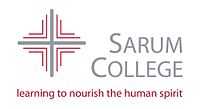Sarum College
| Sarum College | |
|---|---|
| Established |
1860 – Salisbury Theological College |
| Principal | Canon Keith Lamdin |
| Location | Salisbury, Wiltshire, England |
| Website | http://www.sarum.ac.uk |
 | |
Sarum College is an ecumenical Christian institution in Salisbury, England. The college was established in 1995 and occupies the buildings formerly home to the Salisbury and Wells Theological College. It sits within the Cathedral Close on the north side of Salisbury Cathedral.
The Sarum College education programme ranges from short courses to postgraduate level, including certificates, diplomas and masters degrees courses in Christian spirituality, theology, imagination and culture, liturgy and Christian approaches to leadership.[1]
The onsite theological library holds a collection of more than 35,000 books and journals which is open to students and the general public.[2]
The college is a meeting and conference centre for groups, organisations and businesses and welcomes individuals for private stays, including B&B, study breaks, sabbaticals and retreats.[3]
History
The history of theological study begins with Saint Osmund and the completion of the first cathedral at Old Sarum in 1092. After Old Sarum was abandoned in favour of New Sarum (or Salisbury, as it came to be known) and the new cathedral was built in the 1220s, several colleges were established.
There is a long-standing tradition that there was a medieval school of theology on the site of No. 19. It was at this time that Salisbury nearly became a university city to rival Oxford and Cambridge, but history took a different turn.
Main building
The main building at the front of the site was built in 1677 and has long been attributed to Sir Christopher Wren for Francis Hill, a distinguished London lawyer and deputy recorder for Salisbury. He chose a particularly striking site, at the north end of Bishop's Walk, facing directly down to the Bishop's Palace (now the Cathedral School). The house remained in the Hill family until the end of the 18th century. In February 1952 the main building was designated as a Grade I listed building.
Theological college
Bishop Hamilton established the theological college here in 1860 – buying the house (then No. 87) from Charlotte Wyndham – and the first students arrived in January 1861.
In the 1870s the college expanded, with the addition of a residential wing (the "Butterfield Wing") to provide accommodation for students, and then a chapel. A donation of £4750 was given by Sidney Lear, sister of the archdeacon, for the new buildings. The extensions were designed by William Butterfield, one of the foremost church architects of his time and best known for Keble College, Oxford. The chapel was consecrated in 1881.
World War I
Eight students of Salisbury Theological College were killed in World War I (1914–18) and a memorial in the chapel records their names.
In 1937 further extensions were added – consisting of study bedrooms for students, a new library (now the common room) – designed by William Randoll Blacking. These rooms are now known as the Baker Wing.
World War II
During the Second World War (1939–45) the college was taken over by the women of the Auxiliary Territorial Service and Queen Mary paid them a visit. Apparently the creepers which covered the front of the building were hastily removed, as the Queen did not like them.[citation needed]
Merger
In October 1971 the two theological colleges of Salisbury and Wells merged. The Wells students came to No. 19 and the Salisbury & Wells Theological College was formed. The arrival of extra students required more space and two extensions were built: a three storey block of flats and study bedrooms at the eastern end of the Butterfield building (the East Wing) and a new chapel, refectory and library were added at the northern end.
Present
In 1994 the Salisbury & Wells College closed and the following year Sarum College was established to provide a place of ecumenical theological education – as well as a home for ministerial training through the Southern Theological Education and Training Scheme (STETS).
The buildings of Sarum College record the changing uses to which the college has been put over the years. A lift was opened in 2005 to provide access to all floors for visitors with disabilities. In 2007 the college completed the refurbishment of the attic bedrooms (formerly servants’ quarters) and en-suite bedrooms for visitors. Further works began in July 2011 to upgrade the building infrastructure and convert standard bedrooms to en-suite.
Academic staff
- David Catchpole – Scholar in Residence[4]
- Jane Gledhill – Lecturer in Christian Spirituality[5]
- Colin Greene – Programme Leader for the MA in Theology, Imagination and Culture[6]
- Tim Harle – Lecturer in Leadership[7]
- Keith Lamdin – Principal of Sarum College and Programme Leader for the MA in Christian Approaches to Leadership[8]
- Patrick Moore – Scholar in Residence[9]
- Barbara Mosse – Scholar in Residence[10]
- Louise Nelstrop – Programme Leader for the MA in Christian Spirituality[11]
- Tony Nolan – Programme Leader for the Spirituality in Everyday Life courses[12]
- James Steven – Programme Leader for the MA in Christian Liturgy[13]
References
- ↑ "Prospective Students". Retrieved 23 October 2012.
- ↑ "Sarum College Library". Retrieved 23 October 2012.
- ↑ "Conference Venue". Retrieved 23 October 2012.
- ↑ "David Catchpole". Retrieved 23 October 2012.
- ↑ "Jane Gledhill". Retrieved 23 October 2012.
- ↑ "Colin Greene". Retrieved 23 October 2012.
- ↑ "Tim Harle". Retrieved 23 October 2012.
- ↑ "Kieth Lamdin". Retrieved 23 October 2012.
- ↑ "Patrick Moore". Retrieved 23 October 2012.
- ↑ "Barbara Mosse". Retrieved 23 October 2012.
- ↑ "Louise Nelstrop". Retrieved 23 October 2012.
- ↑ "Tony Nolan". Retrieved 23 October 2012.
- ↑ "James Steven". Retrieved 23 October 2012.